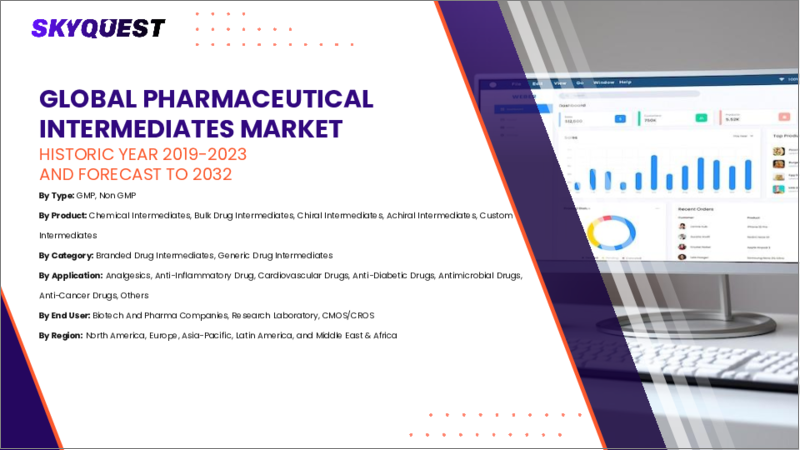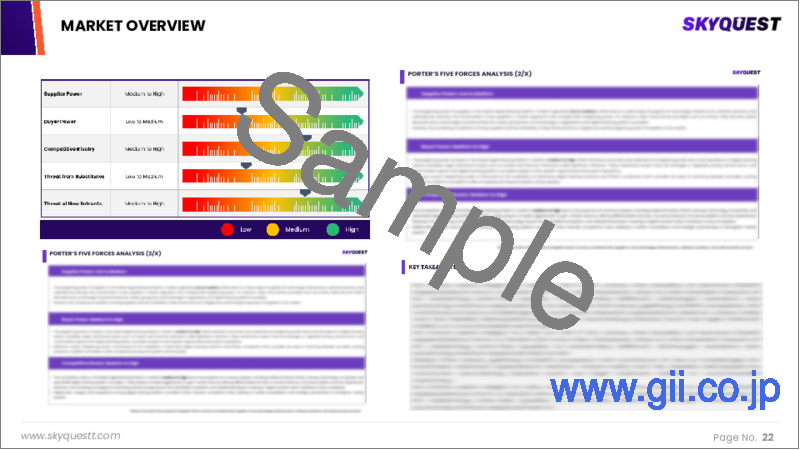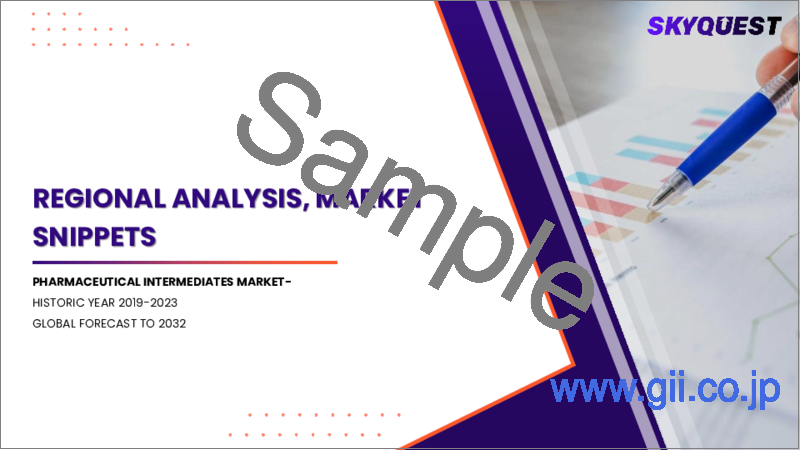|
|
市場調査レポート
商品コード
1619045
医薬品中間体市場規模、シェア、成長分析、製品別、カテゴリー別、用途別、エンドユーザー別、地域別 - 産業別予測、2024~2031年Pharmaceutical Intermediates Market Size, Share, Growth Analysis, By Product, By Category, By Application, By End User, By Region - Industry Forecast 2024-2031 |
||||||
|
|||||||
| 医薬品中間体市場規模、シェア、成長分析、製品別、カテゴリー別、用途別、エンドユーザー別、地域別 - 産業別予測、2024~2031年 |
|
出版日: 2024年12月18日
発行: SkyQuest
ページ情報: 英文 157 Pages
納期: 3~5営業日
|
全表示
- 概要
- 目次
医薬品中間体の世界市場規模は、2022年に291億8,000万米ドルと評価され、2023年の312億5,000万米ドルから2031年には541億米ドルに成長し、予測期間(2024~2031年)のCAGRは7.1%で成長する見通しです。
医薬品中間体市場は、これらの中間体が医薬品有効成分(API)生産に不可欠な原料として機能することから、医薬品および化粧品セクターにおける需要の高まりに牽引され、大幅な成長を遂げています。ハイテク治療や個別化医療への注目が高まる中、APIへのニーズは高まっており、市場の拡大に拍車をかけています。しかし、バイオ医薬品に関連する高コストや、原薬生産に必要な多額の設備投資といった課題は、成長の妨げになる可能性があります。とはいえ、製造技術の新興国市場の進展と研究開発投資の増加により、市場開拓のチャンスは大きく広がっています。高品質の基礎原料を活用することで、この分野は医薬品や農薬製造の多様なニーズに応えながら進化を続けると思われます。
目次
イントロダクション
- 調査の目的
- 調査範囲
- 定義
調査手法
- 情報調達
- 二次データと一次データの方法
- 市場規模予測
- 市場の前提条件と制限
エグゼクティブサマリー
- 世界市場の見通し
- 供給と需要の動向分析
- セグメント別機会分析
市場力学と見通し
- 市場概要
- 市場規模
- 市場力学
- 促進要因と機会
- 抑制要因と課題
- ポーターの分析
主な市場の考察
- 重要成功要因
- 競合の程度
- 主な投資機会
- 市場エコシステム
- 市場の魅力指数(2023年)
- PESTEL分析
- マクロ経済指標
- バリューチェーン分析
- 価格分析
- 規制分析
- 特許分析
- ケーススタディ分析
医薬品中間体市場規模:製品別およびCAGR(2024~2031年)
- 市場概要
- 化学中間体
- バルク医薬品中間体
- キラル中間体
- アキラル中間体
- カスタム中間体
医薬品中間体市場規模:カテゴリー別およびCAGR(2024~2031年)
- 市場概要
- ブランド医薬品中間体
- ジェネリック医薬品中間体
医薬品中間体市場規模:用途別およびCAGR(2024~2031年)
- 市場概要
- 鎮痛剤
- 抗炎症薬
- 心臓血管薬
- 抗糖尿病薬
- 抗菌薬
- 抗がん剤
- その他
医薬品中間体市場規模:エンドユーザー別およびCAGR(2024~2031年)
- 市場概要
- バイオテクノロジーおよび製薬企業
- 調査室
- CMOS/クロス
医薬品中間体市場規模およびCAGR(2024~2031年)
- 北米
- 米国
- カナダ
- 欧州
- ドイツ
- スペイン
- フランス
- 英国
- イタリア
- その他欧州地域
- アジア太平洋地域
- 中国
- インド
- 日本
- 韓国
- その他アジア太平洋地域
- ラテンアメリカ
- ブラジル
- その他ラテンアメリカ地域
- 中東・アフリカ
- GCC諸国
- 南アフリカ
- その他中東・アフリカ
競合情報
- 上位5社の比較
- 主要企業の市場ポジショニング(2023年)
- 主な市場企業が採用した戦略
- 市場の最近の動向
- 企業の市場シェア分析(2023年)
- 主要企業の企業プロファイル
- 会社概要
- 製品ポートフォリオ分析
- セグメント別シェア分析
- 収益の前年比比較(2021~2023年)
主要企業プロファイル
- BASF SE(Germany)
- Sanofi SA(France)
- Thermo Fisher Scientific Inc.(US)
- Merck KGaA(Germany)
- Dishman Carbogen Amcis Ltd.(India)
- Evonik Industries AG(Germany)
- Arkema Inc.(France)
- Lonza Group AG(Switzerland)
- Wuxi AppTec Co., Ltd.(China)
- Aurobindo Pharma Limited(India)
- Lianhe Chemical Technology Co., Ltd.(China)
- Cambrex Corporation(US)
- Vertellus Holdings LLC(US)
- Hovione LLC(Portugal)
- Hikal Ltd.(India)
- Codexis Inc.(US)
- Aceto Corporation(US)
- Interchem Corporation(US)
- Midas Pharma GmbH(Germany)
- Arbiom(US)
結論と推奨事項
Global Pharmaceutical Intermediates Market size was valued at USD 29.18 billion in 2022 and is poised to grow from USD 31.25 billion in 2023 to USD 54.1 billion by 2031, growing at a CAGR of 7.1% during the forecast period (2024-2031).
The pharmaceutical intermediates market is witnessing substantial growth, driven by rising demand in the pharmaceutical and cosmetic sectors as these intermediates serve as essential raw materials in active pharmaceutical ingredient (API) production. With the growing focus on high-tech therapies and personalized medicine, the need for APIs is escalating, further fueling market expansion. However, challenges such as high costs associated with biopharmaceuticals and the significant capital investment required for API production could hinder growth. Nevertheless, advancements in manufacturing technologies and increased investment in research and development are poised to unlock considerable opportunities within the market. By leveraging quality basic materials, the sector is set to continue evolving, catering to the diverse needs of drug and pesticide production.
Top-down and bottom-up approaches were used to estimate and validate the size of the Global Pharmaceutical Intermediates market and to estimate the size of various other dependent submarkets. The research methodology used to estimate the market size includes the following details: The key players in the market were identified through secondary research, and their market shares in the respective regions were determined through primary and secondary research. This entire procedure includes the study of the annual and financial reports of the top market players and extensive interviews for key insights from industry leaders such as CEOs, VPs, directors, and marketing executives. All percentage shares split, and breakdowns were determined using secondary sources and verified through Primary sources. All possible parameters that affect the markets covered in this research study have been accounted for, viewed in extensive detail, verified through primary research, and analyzed to get the final quantitative and qualitative data.
Global Pharmaceutical Intermediates Market Segmental Analysis
Global Pharmaceutical Intermediates Market is segmented by product, category, application, end user and region. Based on product, the market is segmented into chemical intermediates, bulk drug intermediates, chiral intermediates, achiral intermediates and custom intermediates. Based on category, the market is segmented into branded drug intermediates and generic drug intermediates. Based on application, the market is segmented into analgesics, anti-inflammatory drug, cardiovascular drugs, anti-diabetic drugs, antimicrobial drugs, anti-cancer drugs and others. Based on end user, the market is segmented into biotech and pharma companies, research laboratory and CMOS/CROS. Based on region, the market is segmented into North America, Europe, Asia Pacific, Latin America and Middle East & Africa.
Driver of the Global Pharmaceutical Intermediates Market
The Global Pharmaceutical Intermediates market is significantly driven by the rising prevalence of chronic diseases and the aging demographic across the globe. The World Health Organization (WHO) notes that the number of diabetes cases soared from 108 million in 1980 to 422 million by 2014, and this upward trend persists. Moreover, WHO projects that chronic diseases will surge by 57% by 2020, revealing that a considerable proportion of the population is affected. These alarming statistics underscore the escalating demand for drug formulations aimed at managing chronic conditions, thereby fueling substantial growth in the Pharmaceutical Intermediates market during the forecast period.
Restraints in the Global Pharmaceutical Intermediates Market
One significant restraint affecting the global pharmaceutical intermediates market is the substantial expense linked to acquiring biopharmaceutical drugs. This high financial burden not only limits accessibility for many companies but also restricts their ability to invest in research and development. Additionally, the considerable capital investment necessary for the production of active pharmaceutical ingredients (APIs) further hinders market growth. These financial challenges can deter new entrants and stifle innovation within the industry, ultimately impacting the overall development and supply chain of pharmaceutical intermediates and creating barriers to fulfilling market demand.
Market Trends of the Global Pharmaceutical Intermediates Market
The Global Pharmaceutical Intermediates market is experiencing significant growth driven by the escalating prevalence of chronic cardiovascular diseases, particularly ischemic heart disease (IHD), which is projected to impact over 126 million individuals worldwide. As IHD emerges as the leading cause of death globally, with forecasts suggesting an alarming increase to 1,845 cases per 100,000 individuals by 2030, the demand for pharmaceutical intermediates essential for the production of cardiovascular medications is surging. This trend accentuates the urgent need for innovation in drug formulation and production, positioning pharmaceutical intermediates as a critical sector in addressing rising healthcare costs associated with heart disease.
Table of Contents
Introduction
- Objectives of the Study
- Scope of the Report
- Definitions
Research Methodology
- Information Procurement
- Secondary & Primary Data Methods
- Market Size Estimation
- Market Assumptions & Limitations
Executive Summary
- Global Market Outlook
- Supply & Demand Trend Analysis
- Segmental Opportunity Analysis
Market Dynamics & Outlook
- Market Overview
- Market Size
- Market Dynamics
- Drivers & Opportunities
- Restraints & Challenges
- Porters Analysis
- Competitive rivalry
- Threat of substitute
- Bargaining power of buyers
- Threat of new entrants
- Bargaining power of suppliers
Key Market Insights
- Key Success Factors
- Degree of Competition
- Top Investment Pockets
- Market Ecosystem
- Market Attractiveness Index, 2023
- PESTEL Analysis
- Macro-Economic Indicators
- Value Chain Analysis
- Pricing Analysis
- Regulatory Analysis
- Patent Analysis
- Case Study Analysis
Global Pharmaceutical Intermediates Market Size by Product & CAGR (2024-2031)
- Market Overview
- Chemical Intermediates
- Bulk Drug Intermediates
- Chiral Intermediates
- Achiral Intermediates
- Custom Intermediates
Global Pharmaceutical Intermediates Market Size by Category & CAGR (2024-2031)
- Market Overview
- Branded Drug Intermediates
- Generic Drug Intermediates
Global Pharmaceutical Intermediates Market Size by Application & CAGR (2024-2031)
- Market Overview
- Analgesics
- Anti-Inflammatory Drug
- Cardiovascular Drugs
- Anti-Diabetic Drugs
- Antimicrobial Drugs
- Anti-Cancer Drugs
- Others
Global Pharmaceutical Intermediates Market Size by End User & CAGR (2024-2031)
- Market Overview
- Biotech and Pharma Companies
- Research Laboratory
- CMOS/CROS
Global Pharmaceutical Intermediates Market Size & CAGR (2024-2031)
- North America (Product, Category, Application, End User)
- USA
- Canada
- Europe (Product, Category, Application, End User)
- Germany
- Spain
- France
- UK
- Italy
- Rest of Europe
- Asia Pacific (Product, Category, Application, End User)
- China
- India
- Japan
- South Korea
- Rest of Asia-Pacific
- Latin America (Product, Category, Application, End User)
- Brazil
- Rest of Latin America
- Middle East & Africa (Product, Category, Application, End User)
- GCC Countries
- South Africa
- Rest of Middle East & Africa
Competitive Intelligence
- Top 5 Player Comparison
- Market Positioning of Key Players, 2023
- Strategies Adopted by Key Market Players
- Recent Developments in the Market
- Company Market Share Analysis, 2023
- Company Profiles of All Key Players
- Company Details
- Product Portfolio Analysis
- Company's Segmental Share Analysis
- Revenue Y-O-Y Comparison (2021-2023)
Key Company Profiles
- BASF SE (Germany)
- Company Overview
- Business Segment Overview
- Financial Updates
- Key Developments
- Sanofi SA (France)
- Company Overview
- Business Segment Overview
- Financial Updates
- Key Developments
- Thermo Fisher Scientific Inc. (US)
- Company Overview
- Business Segment Overview
- Financial Updates
- Key Developments
- Merck KGaA (Germany)
- Company Overview
- Business Segment Overview
- Financial Updates
- Key Developments
- Dishman Carbogen Amcis Ltd. (India)
- Company Overview
- Business Segment Overview
- Financial Updates
- Key Developments
- Evonik Industries AG (Germany)
- Company Overview
- Business Segment Overview
- Financial Updates
- Key Developments
- Arkema Inc. (France)
- Company Overview
- Business Segment Overview
- Financial Updates
- Key Developments
- Lonza Group AG (Switzerland)
- Company Overview
- Business Segment Overview
- Financial Updates
- Key Developments
- Wuxi AppTec Co., Ltd. (China)
- Company Overview
- Business Segment Overview
- Financial Updates
- Key Developments
- Aurobindo Pharma Limited (India)
- Company Overview
- Business Segment Overview
- Financial Updates
- Key Developments
- Lianhe Chemical Technology Co., Ltd. (China)
- Company Overview
- Business Segment Overview
- Financial Updates
- Key Developments
- Cambrex Corporation (US)
- Company Overview
- Business Segment Overview
- Financial Updates
- Key Developments
- Vertellus Holdings LLC (US)
- Company Overview
- Business Segment Overview
- Financial Updates
- Key Developments
- Hovione LLC (Portugal)
- Company Overview
- Business Segment Overview
- Financial Updates
- Key Developments
- Hikal Ltd. (India)
- Company Overview
- Business Segment Overview
- Financial Updates
- Key Developments
- Codexis Inc. (US)
- Company Overview
- Business Segment Overview
- Financial Updates
- Key Developments
- Aceto Corporation (US)
- Company Overview
- Business Segment Overview
- Financial Updates
- Key Developments
- Interchem Corporation (US)
- Company Overview
- Business Segment Overview
- Financial Updates
- Key Developments
- Midas Pharma GmbH (Germany)
- Company Overview
- Business Segment Overview
- Financial Updates
- Key Developments
- Arbiom (US)
- Company Overview
- Business Segment Overview
- Financial Updates
- Key Developments






